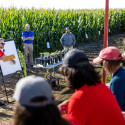New genomic data helps resolve biology’s tree of life
For more than a century, biologists have been working to assign plants, animals and microbes their respective places on the tree of life. More recently, by comparing DNA sequences from a few genes per species, scientists have been trying to construct a grand tree of life that accurately portrays the course of life on Earth, and shows how all organisms are related, one to another.
However, despite the detailed insights provided by individual genes, that approach has proved cumbersome in its ability to resolve the order of events in the distant past.
Now, a team of scientists from the Howard Hughes Medical Institute at the University of Wisconsin–Madison, writing in the current issue (Oct. 23) of the prestigious journal Nature, has shown that new genomic-scale data offers powerful, unprecedented resolution of the evolutionary tree.
The finding is important because an accurate depiction of a tree of life promises biologists a summary of the history of life on Earth during billions of years. Such a rigorous historical framework is an essential backdrop – not just for evolutionary biology, but also for efforts as diverse as the search for new drugs and agricultural agents, studies of emerging diseases, and evaluating issues of species conservation and ecosystem restoration.
“The overall goal is that we want to know who is related to whom,” says Sean B. Carroll, a UW–Madison professor of genetics and the senior author of the Nature paper. “The challenge has been to decipher the true tree from those that have changed as data have been added and re-analyzed over time.”
In efforts to arrive at a reliable tree of life, scientists since the 1980s have used genes to infer the evolutionary history for various organisms. By comparing one or a few genes common to related animals or plants, and looking at differences in the selected genes, scientists began to map out family trees for different plants, animals and microbes.
The problem with that approach, according to the new Wisconsin study, is that trees constructed on single genes often seem to lack reliability. Different genes give different answers so that one gene from a group of organisms depicts one tree, while a different gene from the same organisms will paint an entirely different phylogenetic picture. More genes, it has been thought, could help resolve the issue, and the new Wisconsin study now provides the first glimpse at both just how unreliable single genes can be and how many genes might be needed to overcome the problem.
Using new genomic sequences from eight yeast species, the group in Carroll’s lab, which was led by post-doctoral fellows Antonis Rokas, Barry L. Williams and Nicole King, were able to assess the reliability of trees constructed using more than 100 genes. The result was a single tree with no doubt.
“We were shocked. We didn’t expect such an unprecedented level of resolution,” says Rokas. “Some genes give you one story, some genes give you another, but with enough of them together we get a single picture.”
Apparently, the catch with the single-gene model is that some of the thousands of nucleotides that make up a gene can be biased as natural selection acts on the gene to fulfill a certain role. “Each gene carries information concerning both history and selection. Genes alone are biased, but together their shared history overrides each genes’ unique bias and provides a surprisingly strong picture of evolution,” says Williams.
The implications of the study are exciting, and provide encouraging news for the future of understanding the tree of life, says Carroll. As the data sets get larger, the influence of variation caused by natural selection becomes small enough that true historical relationships can be worked out.
“The problem is that molecules don’t all change in the same way,” says Carroll. “Now, with whole genomes being deciphered at a rapid clip, long-standing questions about the relationships between various animals and plants appear to be within our reach.”
The take-home message, according to Williams and Rokas, is that the advent of the genomic age means the data necessary to build robust phylogenetic trees are coming online. Already, scientists have genomic sequences for a number of different organisms, ranging from bacteria to humans.
“It’s time for people to scale up, ” says Rokas. “By increasing the amount of data, we will see a more robust picture of the tree of life.”
Tags: research




